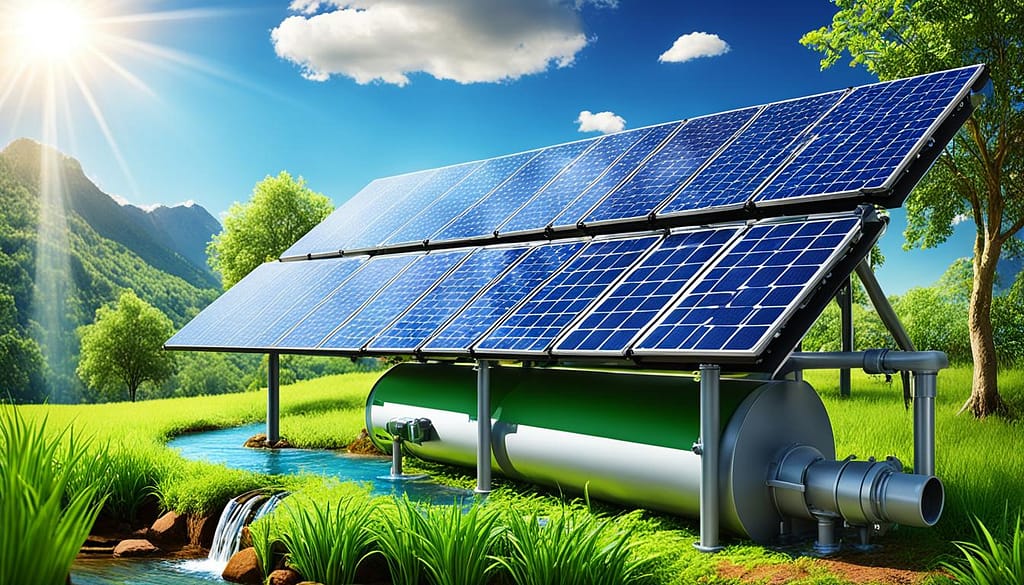A solar water pumping system harnesses renewable energy to meet water pumping needs, making it an eco-friendly solution. With the use of solar panels, this system provides a sustainable and efficient way to extract and distribute water for various applications, including irrigation and water supply. It is particularly beneficial in remote areas with limited grid power access.
The solar water pumping system consists of components such as solar modules, pumps, controllers, and sensors, and offers features like auto ON/OFF for maximizing solar energy utilization. These systems are available in different capacities ranging from 1 HP to 10 HP, with the ability to discharge thousands of liters of water per day at various pump heads. Both the solar modules and the pump come with warranties, ensuring long-term reliability and performance.
Key Takeaways
- Solar water pumping systems use renewable energy to extract and distribute water
- They are ideal for irrigation and water supply in remote areas without grid power access
- Components of the system include solar modules, pumps, controllers, and sensors
- The system offers features like auto ON/OFF for maximizing solar energy utilization
- Solar water pumping systems come with warranties for long-term reliability
Types of Solar Pumping
When it comes to solar pumping systems, there are several types available that cater to different needs and requirements. These systems offer energy-efficient and sustainable solutions for irrigation and water pumping, making them an excellent choice for those seeking environmentally friendly alternatives. Let’s explore the different types of solar pumping systems:
1. Direct Pumping
Direct pumping is a straightforward and efficient option for utilizing solar energy to power water pumps. With this system, solar panels directly generate the energy needed to run the pump. Ideal for applications such as irrigation and water supply in remote locations, direct pumping offers an independent and reliable solution without the need for external power sources. By harnessing the power of the sun, direct pumping provides an eco-friendly and cost-effective approach to water pumping.
2. Pumping with Storage
Solar pumping systems with storage involve the use of batteries to store excess energy generated during the day. These batteries store the energy and allow the pump to operate even during cloudy periods or at night when the sun is not directly available. This ensures a continuous water supply, making it suitable for areas where sunlight may be inconsistent or for applications that require round-the-clock pumping. Pumping with storage provides reliability and flexibility in maintaining water availability.
3. Solar Tracking Pumping
Solar tracking pumping systems incorporate technology that tracks the sun’s path throughout the day. This advanced system optimizes solar energy capture by maximizing the exposure of solar panels to direct sunlight. By continuously adjusting the position of the panels, solar tracking pumping systems ensure maximum efficiency and energy output. These systems are ideal for areas with varying sun angles or when high energy generation is required. Solar tracking pumping systems offer enhanced performance and increased energy harnessing capabilities.
In summary, the different types of solar pumping systems offer a range of solutions to cater to various irrigation and water pumping needs. Whether it’s direct pumping for simplicity and efficiency, pumping with storage for continuous operation, or solar tracking pumping for maximum energy harnessing, solar-powered water pumps provide energy-efficient and sustainable alternatives for water supply. By harnessing the power of the sun, these systems contribute to a greener and more environmentally friendly future.

| Type | Key Features | Applications |
|---|---|---|
| Direct Pumping | Simple and efficient | Remote irrigation and water supply |
| Pumping with Storage | Continuous operation, even during non-sunny periods | Round-the-clock water pumping, areas with inconsistent sunlight |
| Solar Tracking Pumping | Maximizes solar energy capture and system efficiency | Varying sun angles, high energy generation requirements |
How Solar Pumping Works
Solar pumping systems utilize renewable energy from the sun to power water pumps, providing an eco-friendly and sustainable solution for various water pumping needs. The process involves the capture and conversion of solar energy into electricity, which is then used to operate the water pump.
The solar pumping system begins with photovoltaic solar panels that absorb sunlight and convert it into direct current (DC) electrical energy. These panels consist of multiple individual solar cells made of semiconductor materials, such as silicon, that release electrons when exposed to sunlight.
The direct current from the solar panels is then directed to an inverter, which converts the DC power into alternating current (AC). AC is the type of electricity used in most homes and electrical devices, making it compatible with the water pump’s operation.
Once the electrical energy is converted to AC, it is supplied to the water pump. The pump draws water from a source, such as a well or river, and lifts it for distribution to the intended application. The pump’s specifications and capacity depend on the water demand and the distance it needs to lift the water.
Solar pumping systems can incorporate additional components such as controllers and sensors to optimize efficiency. These devices monitor sunlight conditions and water needs, automatically adjusting the pump speed accordingly. By matching the pump’s operation to the available sunlight and water demand, these controllers and sensors maximize energy utilization while conserving power.
Benefits of Solar Pumping Systems
Solar pumping systems offer several advantages compared to traditional water pumping methods:
- Reduced operating costs: Solar energy is free, making solar pumping systems highly cost-effective once the initial installation costs are covered.
- Eco-friendly solution: Solar pumping eliminates the need for fossil fuels, reducing carbon emissions and minimizing environmental impact.
- Reliable operation: With proper maintenance, solar pumps can operate for extended periods without interruptions, ensuring a consistent water supply.
- Ability to operate in remote areas: Solar pumping systems are particularly beneficial in areas with limited access to the electric grid, providing a sustainable solution for water pumping needs.
Overall, solar pumping systems harness the power of renewable energy to provide efficient and sustainable water pumping solutions. By utilizing sunlight, these systems contribute to a greener future while addressing water needs in various applications.
Conclusion
Solar water pumping systems are revolutionizing the way we meet water pumping needs, especially in remote areas with limited grid power access. These systems offer sustainable and eco-friendly solutions that are cost-effective and energy-efficient. Whether it is for irrigation, livestock water supply, or drinking water, solar water pumping systems provide reliable and continuous water supply while minimizing environmental impact.
By harnessing the power of the sun, these systems contribute to a greener future by reducing carbon emissions and reliance on fossil fuels. With low maintenance requirements and a lifespan of up to 25 years, solar water pumping systems ensure long-term reliability and performance. They are a viable and long-lasting solution for sustainable water solutions in remote areas.
Investing in solar water pumping systems not only helps in conserving natural resources but also creates opportunities for self-sufficiency and economic growth. With advancements in technology, these systems are becoming more efficient and accessible. As we embrace eco-friendly water pumping solutions, we take a step towards a more sustainable and resilient future for everyone.
FAQ
What is a solar water pumping system?
A solar water pumping system is an eco-friendly solution that uses renewable energy to meet water pumping needs. It harnesses the power of the sun through solar panels to extract and distribute water for various applications, such as irrigation and water supply.
Where are solar water pumping systems most beneficial?
Solar water pumping systems are particularly beneficial in remote areas with limited access to the electric grid. They offer a sustainable and efficient solution for water pumping needs in these areas, where traditional power sources may not be available.
What components are included in a solar water pumping system?
A solar water pumping system consists of components such as solar modules, pumps, controllers, and sensors. These components work together to capture sunlight, convert it into electrical energy, and pump water from a source like a well or river for distribution.
Are there different types of solar pumping systems available?
Yes, there are different types of solar pumping systems available. These include direct pumping, solar pumping with storage, and solar tracking pumping systems. Each type offers its own advantages and is suitable for different applications and environments.
How do solar pumping systems work?
Solar pumping systems work by capturing sunlight through photovoltaic solar panels. These panels convert sunlight into electrical energy, which is then used to power the water pump. Some systems incorporate controllers and sensors to optimize efficiency and adjust pump speed based on sunlight conditions and water needs.
What are the benefits of using solar water pumping systems?
Solar water pumping systems offer cost-effective and energy-efficient solutions for irrigation, livestock water supply, and drinking water. They rely on renewable energy, reducing carbon emissions and contributing to a greener future. These systems also have low maintenance requirements and can last for up to 25 years with proper care.

